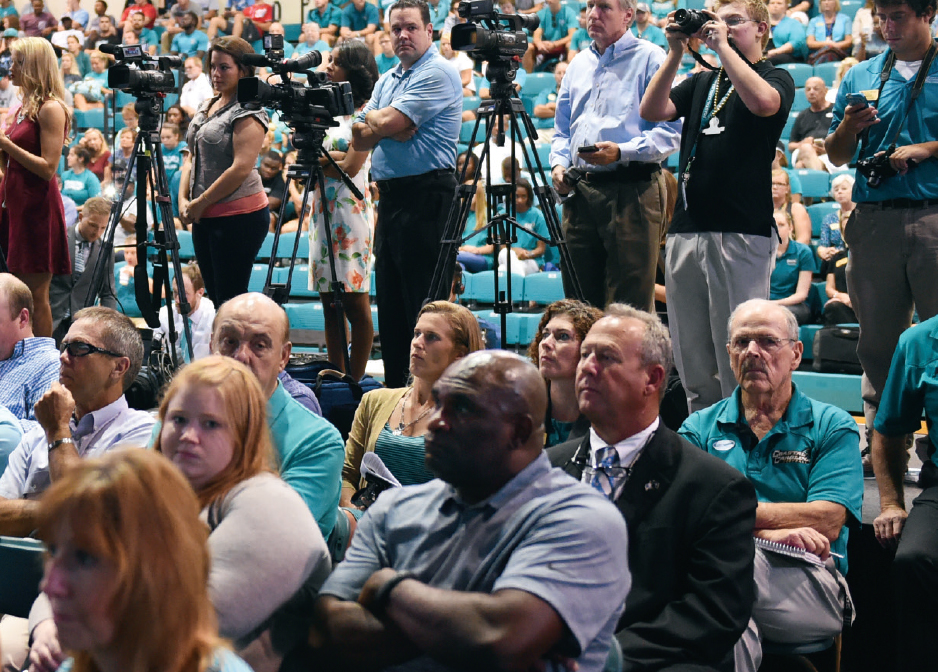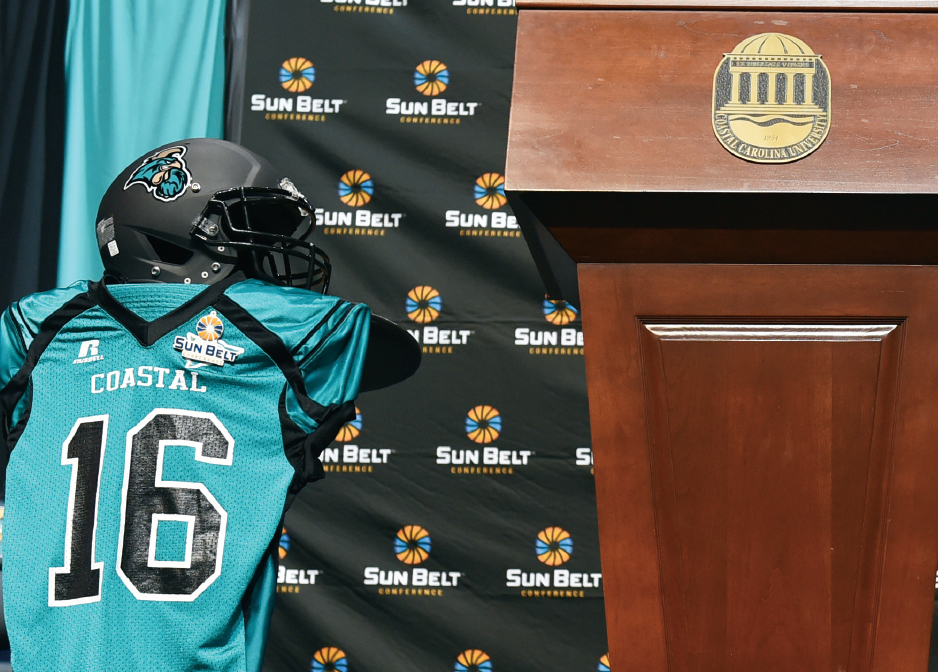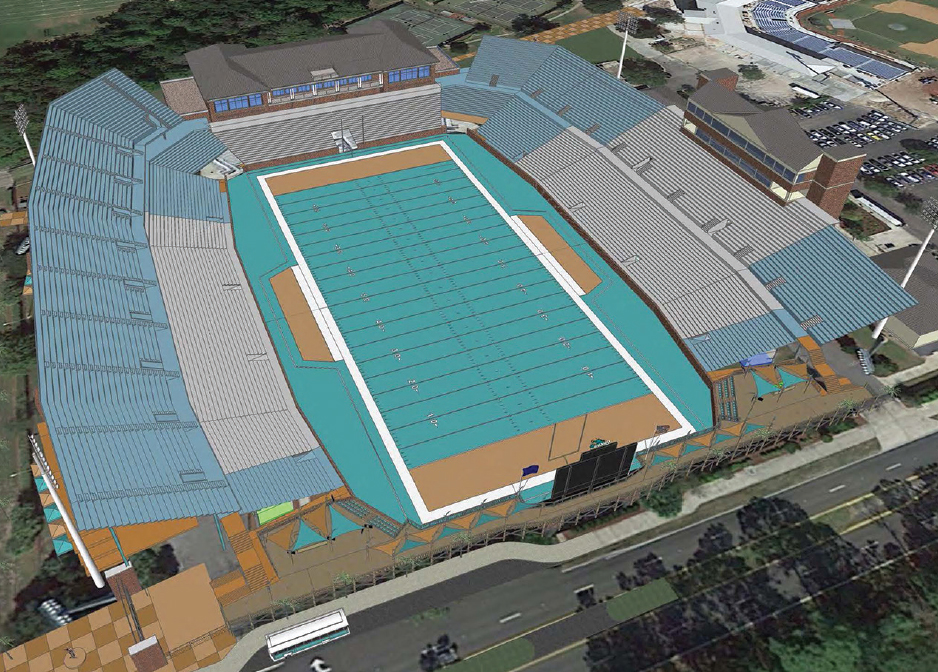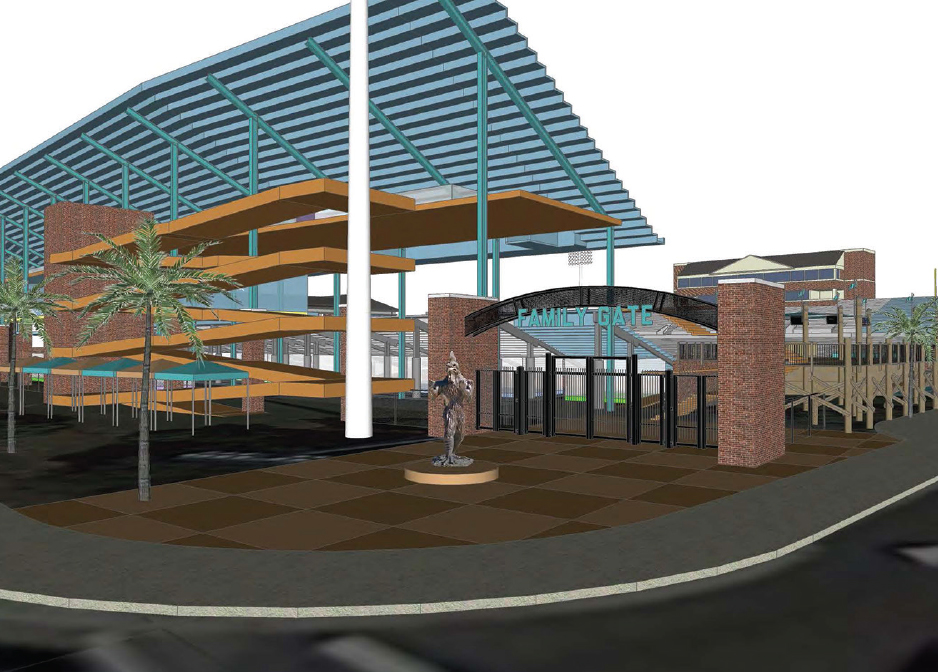
CCU scored a major win with its invitation to join the Sun Belt Conference. CCU Hall of Famer Josh Hoke ’06 explores the advantages and challenges of this game-changing transition for CCU Athletics. by Josh Hoke
Coastal Carolina President David DeCenzo stepped to the lectern on Sept. 1, 2015, and made an announcement that changed the athletic future of his University forever.
When he accepted an invitation into the Sun Belt Conference, a move that puts Coastal’s football program into the highest level of the sport, his decision impacted much more than the future of athletics. For DeCenzo, the move has as much to do with academics as athletics.
“A driving factor was whether it would have a positive impact on the University in general,” he said, “what it could help us do for branding the institution and opening up new markets. When you look at all the academic effects of being associated with schools in the Football Bowl Subdivision, it made sound sense to all of us.”
CCU, a founding member of the Big South Conference in 1983, officially joins the Sun Belt in all sports except football in July 2016. The football program will join the conference in 2017 and will be eligible to win the conference title in its first season, something Georgia Southern did in 2014. CCU won’t be eligible to participate in a postseason bowl game until 2018.
The Chanticleers will certainly have their growing pains, but the school is now among an elite group of 129 other institutions playing football at the FBS level. That immediately brings a certain level of validity to the growth the University has seen over the last decade, both athletically and academically.
“We have the ingredients for success,” said CCU Director of Athletics Matt Hogue. “We have a school on an upward trajectory that continues to create new interest by the day. The advantages are there. We’ve just got to capitalize on them.”
“Coastal Carolina football has great potential,” said Sun Belt Conference Commissioner Karl Benson. “It could be the next Boise State very easily.”
"We have a school on an upward trajectory that continues to create new interest by the day." - Matt Hogue, CCU Director of Athletics
Benson, a Boise State graduate, would certainly understand the parallels between the athletic histories and maturation of the two universities, but many schools making the jump from the FCS to the FBS level over the last two decades have been compared to Boise State. None of them have equaled the Broncos’ off-field prestige or their on-field success since making the jump.
Coastal faces numerous challenges before it can even step on the field as an FBS program. First and foremost, the move up will require an increase in football attendance and thus an expansion of Brooks Stadium. DeCenzo doesn’t want his students paying the construction bill.
Much of that responsibility falls to Chris Johnson, the executive director of the Chanticleer Athletic Foundation, Coastal’s non-profit, athletic fundraising arm. He’s spent much of the fall engaging with individuals and groups along the Grand Strand and throughout South Carolina. Their reaction to Coastal’s move into the highest level of college football has included “excitement and anticipation.”
“One of the biggest challenges we’ve had so far is people understanding the difference between the FCS and FBS levels and what that means,” Johnson said. “Coastal Carolina is now in the same family as Clemson and South Carolina; we are now one of the big three. Down the road, it’s not going to be Clemson-Carolina or Carolina-Clemson. Coastal is going to be included in there, and Coastal isn’t necessarily going to be the last name mentioned.”
With six other South Carolina schools playing at the same level, it was easy for Coastal to get lost in the FCS mix. However, the Chanticleers are about to crash a two-program party that hasn’t had any company since the 1890s, when Clemson and South Carolina both began their football programs. As such, the Tigers and Gamecocks dominated all facets of college football in the state for more than a century.
Coastal’s move may ultimately make its program much more competitive in a number of key areas, including donor engagement. Additional funding allowed Clemson and USC to continue growing their academic and athletic programs when many of the state’s other schools were cash-strapped. But Johnson believes his office is already seeing new interest around the state—much of it from individuals and corporations with only lukewarm interest in Coastal Carolina University before the FBS move—that could help Coastal close the gap.
“I think certainly there is going to be a branding aspect to this that puts us on par with Clemson and South Carolina,” Hogue said. “Considering there is no program in this state that has done that or even contemplated doing that, I think speaks for itself in terms of how people see us as another force.
“With our FBS level status, sponsors know they are going to be guaranteed a spot on ESPN. Right now we can’t do that. We might be able to promise a second or third tier like ESPN3, but we can’t guarantee they’ll be exposed on an upper level. Now we will have benefits we couldn’t offer before.”
With its quarterfinal runs in the FCS playoffs in 2013 and 2014, Coastal became a regular on the ESPN networks. However, the ratings for FCS postseason games typically struggle to match even the least significant bowl games for FBS teams.
“One of the things that helped Boise was that their conference affiliation and regional rivals worked,” said Michael Smith, a staff writer for the Charlotte-based Sports Business Journal. “And obviously they’ve won. Any schools in the Sun Belt that are hoping to take that next step...the best thing they can do is win a bunch of football games. That’s what will help them develop their brand.”
Much of the rationale for Coastal to move out of the Big South and into the Sun Belt is a desire to develop a greater awareness of the school and its excellent academic programs outside of its traditional footprint. The school is popular throughout much of the Eastern Seaboard, but it doesn’t draw many students from states in the Deep South. The Sun Belt has two schools each in Alabama, Arkansas, Georgia, Louisiana and Texas.
Developing fans, students and alumni from those areas could go a long way toward helping Coastal Carolina become a nationally recognized brand.
“Coastal is already the epicenter in our area,” Hogue said. “We know that through economic impact studies and the jobs CCU creates. It is the galvanizing feature for our region and our entire market. But the more that we can do to become a national and even global player—not just on the athletic front but academically and across the board—the more opportunities we create for our area and our market.”
And that’s where Hogue and Co. plan to start. Though they are thinking large-scale, they know this transition won’t be successful if the school can’t get the Grand Strand to embrace the program in its own backyard.
To maintain full FBS membership, CCU must average 15,000 fans per game at Brooks Stadium at least once over a two-year period. The program drew capacity crowds in its first two home games of the 2015 season, though that falls about 5,000 short—both in terms of seating capacity and total bodies—of the minimum. Still, it’s not a problem that other schools making the leap from FCS to FBS haven’t faced and haven’t been able to overcome.
The name recognition and prominence associated with some of Coastal’s future
Sun Belt rivals should aid in total attendance. The Chanticleers are likely to host either Appalachian State or Georgia Southern every season. Both programs have large followings in the region. Plus, Coastal might be able to lure more prominent non-conference opponents to Brooks Stadium if it has early success.
Appalachian State inked a deal last year that will see Wake Forest visit the Mountaineers in 2017 for the first time.
This is a bellwether moment for us. It’s an opportunity to catapult the University to the proverbial next level.”
- President David DeCenzo
However, those opportunities are rare for schools making the jump to the FBS level.
The Chanticleers will likely have to cut their teeth playing big-money games on the road against traditional, power-conference schools. Those paychecks will help offset the higher costs of scholarships and infrastructure needed to compete at the FBS level. The school had already started planning to expand Brooks Stadium before the move. Now Hogue just needs to fill those seats.
“We want people to come and sample the experience if they haven’t already,” he said. “Come to our campus and see what we have to offer. That is what has helped us make this move. When the Sun Belt officials visited, they realized what we had going for us. I think the culture really has changed to a large degree. People want to be engaged and see what we have to offer. Alumni want to be around and want to be involved. We’ve seen our ticket base grow. We’ve see our donations grow. We know it’s going in the right direction, but we have to continue to see it grow.
“Another major aspect to this move is that our department will receive a share of the Sun Belt’s College Football Playoff revenue distribution, which will be a base amount of approximately $1 million each year, guaranteed,” said Hogue. “That, combined with larger NCAA basketball tournament distributions and higher payouts for a guarantee football game, provide us access to unprecedented revenue sources.”
DeCenzo isn’t worried.
“Remember what football did for this institution back in 2002,” he said. “I think you are going to see a resurgence in that kind of growth and that kind of attention paid to the school now that it’s moving into FBS,” he said. “Any time you move like we’re doing, it’s going to take time to adjust. But Coastal has always shown that it’s resilient, it’s flexible and it meets the challenges ahead...I think this is a bellwether moment for us. It’s an opportunity to catapult the University to the proverbial next level.”
Brooks Stadium
CCU’s Brooks Stadium, home of the Chanticleer football program, will be significantly expanded over the next couple of years. In order to meet NCAA requirements for the move from the second-tier Football Championship Subdivision (FCS) to the top-tier Football Bowl Subdivision (FBS), the stadium, which currently has 9,124 seats, will undergo a renovation that will increase its seating capacity to 20,000 by March 2018.
The majority of the additions will take place on the west stands near S.C. 544. The renovation project will include a new suite level and fan amenities throughout the stadium, including more restrooms and concessions, better entrances and exits, and improvements in the shuttle system transporting fans from the parking lots to the stadium and back.
The design for the renovation is by Stubbs Muldrow Herin Architects in conjunction with Heery International.
While all other CCU sports will transition into the Sun Belt Conference on July 1, 2016, the football program will not achieve full FBS status until 2018. During the transition, CCU football will compete as a Sun Belt member in 2017 and have the opportunity to compete for the conference football championship, but will not be eligible to participate in the postseason until 2018.






